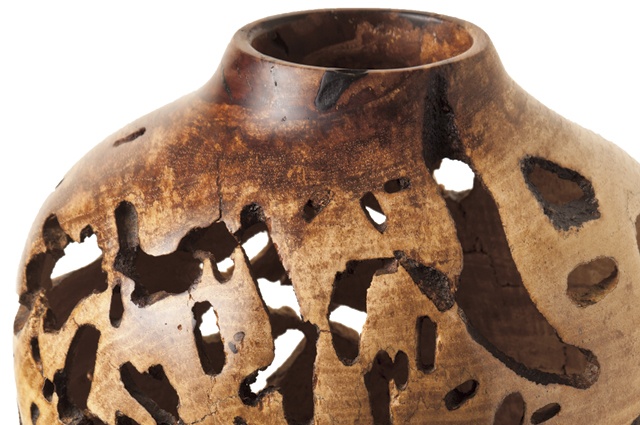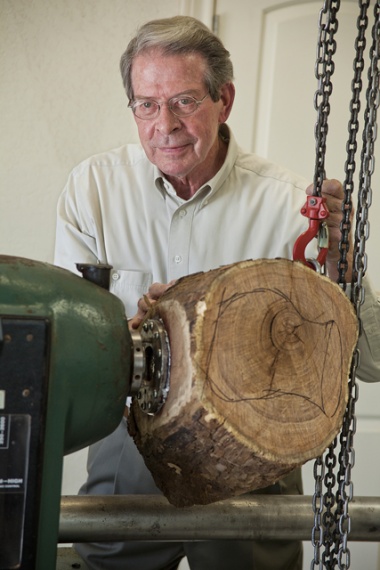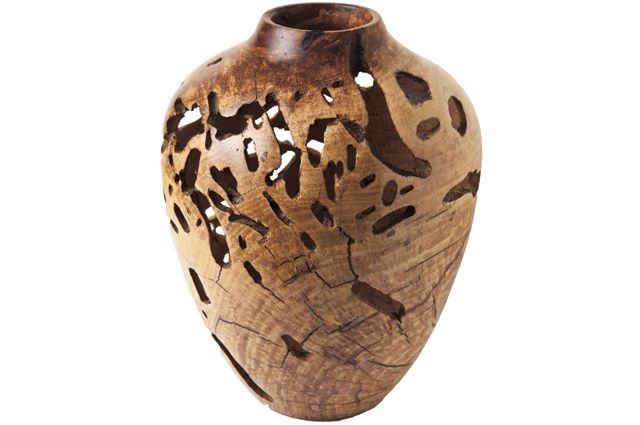Show Stuart Dowlen a straight, flawless wood log, ask him what he can make of it, and he’ll tell you.
Firewood.
Hand him a couple-hundred-pound hunk of gnarly, knotted timber scarred with wormholes or some other hideous imperfection, and he’ll smile.
“You take all the scruffy-looking, ugly logs, and you expose their beauty,” says the 78-year-old Central Texas woodturner. “You give it a pleasant shape, and Mother Nature will do the rest.”
Mother Nature may have gotten the easy part of the deal, for the slender, impeccably dressed and bespectacled Dowlen can only bring to bear what tools man’s created. When he’s finished paring a spinning tree trunk with chisels, hewing nature’s remainders into bowls and vases, smooth as glass and lovingly hand-waxed, chances are it’s taken him the better part of year.
Attached to the garage in Dowlen’s stucco home in a gated community in Spring Branch, a small postal code between San Antonio and Blanco, is a two-story subunit with bath and shower. Therein lie the tools of his trade—band saw, drill press, table saw, clamps and an assortment of sandpaper, chisels, epoxy, superglue and other attachments, some custom-made.
The centerpiece is a customized high-end lathe that can turn up to 2,400 revolutions per minute and could hold a piece of wood 36 inches in diameter, if, in Dowlen’s words, “I had the nerve.” White floors and white walls would show the sawdust—if Dowlen’s sense of tidiness would allow any.
Upstairs, in an empty room, the finished pieces are set out for the searing Texas heat to do its part. It can take six months for the wood to dry out. The pieces are weighed monthly, and when their weight is constant for consecutive months, they’re dried.
Then they’re sanded—he has up to a very fine 2,500-grit paper and is virtually searching Europe for a stash of the treasured 4,000-grit—and waxed to a sheen. Dowlen leaves the inside unfinished to leave no doubt that these are made of wood and not an artsy resin cast. Then he dates, signs and numbers them (No. 189 as of July). But he does not sell them—though he’s been offered as much as $10,000. Instead, he gives them to friends and philanthropic auctions, where they usually raise between $2,500 and $3,500.
Usually, Dowlen gets to his workshop about 9 a.m. and works two to three hours. The window for work in the open-air workshop is as much limited by the Texas heat as by the physical demands—as anyone who’s ever worked a lathe chisel can attest.
On his hands are thick leather gloves. On his head is the Airshot Pro, a protective helmet and Darth Vader starter kit that spares him the bother of having to cough up wood chunks and pick splinters out of his eyes.
If you could see Dowlen’s eyes through the visor, they’d be sparkling. He is clearly making up for lost time. Back in shop class at Amarillo Middle School, he turned a pair of lamp bases, and, metaphorically, a light went on in his head. But then came college and a career in petroleum exploration sales. “I spent most of my time,” he says, “in airports and oil fields.”
But one trip took him to Millersdale, England, the home of woodturning, where he vowed that one day …
That day came in 1993, five years into his dabbling in woodturning, when Atlantic Richfield Co. offered him a lucrative “enhanced retirement.” Within nine months, however, his first wife died from cancer. Still three projects short of completing apprenticeship to a master woodturner, but wanting a new start, he moved from Houston back to Amarillo. There, he met his second wife, Carolyn, whom he married in 1998. They moved to Blanco in 2006, when he set up shop.
“For many, woodturning is almost spiritual—shaping and decorating the natural wood, much as a potter would shape the clay with his hands,” says Janice Levi, president of the Southwest Association of Turners, which has 22 chapters and about 1,500 members in Texas. “For others, it is pure engineering—calculating designs and proportion, placing segments. And yet, the two meet happily in the middle in their satisfaction that they have created something unique.”
Dowlen is both. “Him being a chemist (by education), he has an analytical mind and an artist’s mind,” Carolyn says. “He’s probably truly in the middle.”
So half of him draws detailed plans on graph paper and half of him dreams. Someday, he’d like to try his hand at a hunk of leadwood, an African wood so dense it can’t float, or a yew from Europe, assuming he can keep its toxicity from killing him, or—brace yourself— a 600-pound burl from a tree that was covered in ash but not incinerated when Mount St. Helens erupted in Washington in 1980.
For now, it’s back to the lathe, where he’s turning a vase from the ugliest piece of mesquite found in a creek bed after a flood as a wedding present for his great niece. Plans? Yes, he’s got a vision, but nature has the final say in what figures to be a 100-hour job on the lathe alone, where one wrong move, and it’s firewood.
——————–
Mark Wangrin is an Austin writer.




